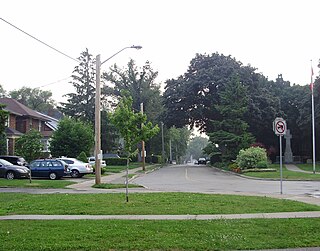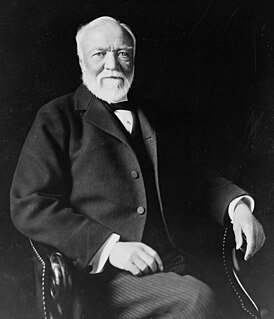
Tottenville is the southernmost neighborhood of Staten Island, New York City and New York State, with an area of approximately 1.7 square miles (4.4 km2). Originally named Bentley Manor by one of its first settlers, Captain Christopher Billop (1638–1726), after a small ship he owned named the Bentley, the district was renamed Tottenville in 1869, apparently in honor of the locally prominent Totten family, whose name can be seen on tombstones in one of the earliest churches, Bethel Methodist Church, on Amboy Road. The neighborhood is represented in the New York City Council by Joe Borelli and in the New York State Assembly by Michael Reilly. Tottenville is located within Staten Island Community Board 3.

The Mother Bethel African Methodist Episcopal Church is a historic church and congregation at 419 South 6th Street in Center City Philadelphia, Pennsylvania, USA. The congregation, founded in 1794, is the oldest African Methodist Episcopal congregation in the nation. Its present church, completed in 1890, is the oldest church property in the United States to be continuously owned by African Americans. It was designated a National Historic Landmark in 1972.

Mimico is a neighbourhood and a former municipality in Toronto, Ontario, Canada, being located in the south-west area of Toronto on Lake Ontario. It is in the south-east corner of the former Township of Etobicoke, and was an independent municipality from 1911 to 1967.

The First Roumanian-American Congregation, also known as Congregation Shaarey Shomayim, or the Roumanishe Shul, was an Orthodox Jewish congregation that, for over 100 years, occupied a historic building at 89–93 Rivington Street on the Lower East Side of Manhattan, New York.

St. George's United Methodist Church, located at the corner of 4th and New Streets, in the Old City neighborhood of Philadelphia, is the oldest Methodist church in continuous use in the United States, beginning in 1769. The congregation was founded in 1767, meeting initially in a sail loft on Dock Street, and in 1769 it purchased the shell of a building which had been erected in 1763 by a German Reformed congregation. At this time, Methodists had not yet broken away from the Anglican Church and the Methodist Episcopal Church was not founded until 1784.

Church Street United Methodist Church is a United Methodist church located on Henley Street in downtown Knoxville, Tennessee. The church building is considered a Knoxville landmark and is listed on the National Register of Historic Places.

Christ Church founded in 1705 is a historic Episcopal parish located at 61 East Main Street in Oyster Bay, New York. Several church buildings have occupied this site, including one that served as soldiers barracks during the Revolutionary War. In the 1870s a Carpenter Gothic style building was erected. In 1925 it was greatly enlarged and encased in stone. Those additions also included striking stained glass windows. President Theodore Roosevelt attended church here, and his wife and children were active members. Roosevelt's funeral service was held here in 1919. Today Christ Church is a featured site on the Oyster Bay History Walk audio walking tour.
The Oyster Bay History Walk is a path through downtown Oyster Bay, New York that leads the walker to 30 historic sites. It is a 1-mile loop and is the first certified American Heart Association Start! Walking Path on Long Island.

The Oyster Bay Bank Building was constructed in 1891 and served as the first bank in Oyster Bay on Long Island, New York. In addition to the bank, other users have included the Masons of Matinecock Lodge, Theodore Roosevelt while he served as Governor of New York, and architect Edward Durrell Stone. Today this building is a featured site on the Oyster Bay History Walk audio walking tour.
Wightman Memorial Baptist Church in Oyster Bay, New York, was first built in 1908. It is the third building on this site. The first Baptist congregation met in Oyster Bay as early as 1700, and Oyster Bay received its first ordained minister in 1724. The second church building, constructed in 1806 is still visible on the site, behind the newer structure.

Hood African Methodist Episcopal Zion Church founded in 1848 is an historic African Methodist Episcopal Zion church located in Oyster Bay, New York. It is the oldest continuous congregation holding services in its original church structure in Oyster Bay. A small wood frame building was constructed on this site in 1856. Later the church was renamed to honor an early bishop, the Right Reverend James Walker Hood. In 1937, the wooden church was covered with the brick exterior you see today. From 1937 to 1963 the pastor was Reverend Moses T. Smith. Today the congregation is led by Reverend Kenneth Nelson, who came to the Hood AME Zion Church in 1981. Reverend Kenneth Nelson retired in June, 2013 and the Reverend Linda B. Vanager was appointed to the Pastoral charge.

The Church of St. Dominic is a Roman Catholic parish church in the Roman Catholic Diocese of Rockville Centre, in Oyster Bay, New York. The parish was founded in the late nineteenth century.

The Bethel Methodist Episcopal Church is located west of Pleasant City, Ohio on SR 146. The church was placed on the National Register of Historic Places on November 24, 1978.

St. Paul's Methodist Episcopal Church, known more recently as the Templo Sion Pentecostal Church, is a historic church at 1886-1906 Park Street in Hartford, Connecticut, United States. Built in 1900, it is a good example of Romanesque Revival design. It was built for a working-class congregation to a design by the nationally known church architect George W. Kramer, proponent of the Akron plan of church interiors, which this one follows. The church was added to the National Register of Historic Places in 1984.

Bethel Methodist Church is a historic Methodist church building in rural Clermont County, Ohio, United States. Built in the 1810s under the leadership of one of Ohio's earliest Methodist preachers, it has survived the death of its congregation, and it remains in use for community activities. Together with its cemetery, the building continues to be used occasionally, and it has been named a historic site.

The Bethel A.M.E. Church, known in its early years as Indianapolis Station or the Vermont Street Church, is a historic African Methodist Episcopal Church in Indianapolis, Indiana. Organized in 1836, it is the city's oldest African-American congregation. The three-story church on West Vermont Street dates to 1869 and was added to the National Register in 1991. The surrounding neighborhood, once the heart of downtown Indianapolis's African American community, significantly changed with post-World War II urban development that included new hotels, apartments, office space, museums, and the Indiana University–Purdue University at Indianapolis campus. In 2016 the congregation sold their deteriorating church, which will be used in a future commercial development. The congregation intends to erect a new Bethel AME Church on Zionsville Road in Pike Township, Marion County, Indiana.

Burnley, in Lancashire, England, has a long history of religious worship, dating from at least before 1122 in the case of the Church of England. The chapel at Towneley Hall was the centre for Roman Catholic worship in Burnley until modern times. Well before the Industrial Revolution, the town saw the emergence of many non-conformist churches and chapels. In 1891 the town was the location of the meeting which saw the creation of the Baptist Union of Great Britain and Ireland. In the late 19th century a Jewish synagogue was established, and in recent times evangelical and free churches have appeared, as well as a large purpose-built mosque.

Morris Brown was one of the founders of the African Methodist Episcopal Church, and its second presiding bishop. He founded Emanuel AME Church in his native Charleston, South Carolina as well as conferences of AME churches in the American Midwest and Canada.





















